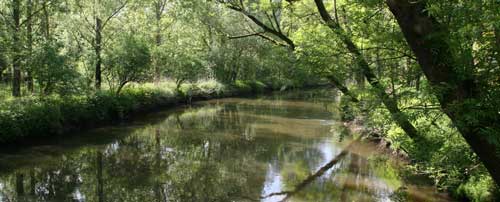| Posted: Oct 17, 2016 |
Fate of nano- and microplastic in rivers explained
(Nanowerk News) Very tiny plastic particles of micro and nano size are difficult to measure in the environment to assess exposure risks. Researchers of Wageningen University & Research now provide the first mechanistic modelling study on the behaviour and fate of nano- and microplastic in surface waters.
|
 |
|
Plastic debris has been detected in the oceans, in soils, sediments and surface waters worldwide. Emissions are expected to increase by an order of magnitude in the coming years. Fragmentation leads to smaller and smaller particles, eventually reaching the submicron scale. At these very small sizes, plastic particles may pose unforeseen risks. Yet they are hard to measure in the environment so that exposure assessments have to rely on modelling.
|
|
Wageningen researcher Ellen Besseling: "We already knew that microplastics are transported in rivers and can reach the sediment, potentially affecting aquatic life. Now we have a theoretical tool that helps us to understand why/how this happens and that helps us to explain what we see. This is important in order to design mitigation strategies for plastic debris of all sizes, and to predict emissions of plastics to our oceans."
|
|
Modeling nano- and microplastic in rivers
|
|
In their recent pioneering study published in the journal Environmental Pollution ("Fate of nano- and microplastic in freshwater systems: A modeling study"), Ellen Besseling and co-workers simulate the concentrations of plastic particles between 100 nm up to 10 mm for the hydrological flow regime of a real river.
|
|
The model accounted for direct transport of the particles, but also for aggregation of the particles with natural suspended solids, and the transport and settling of the resulting so-called heteroaggregates. The model also accounted for the presence of biofilm on the plastics, and model scenarios were calculated for plastics of different density.
|
|
“This provides very insightful results on where in the river bed the ‘hot spot’ locations for presence of nano- and microplastic can be expected,” says project leader Prof Bart Koelmans.
|
|
No earlier models accounted for all of these processes, and some counterintuitive results were obtained. Settling to the sediment for instance, was important for nano- and microplastics smaller than one micrometer due to settling of aggregates, and for plastic particles bigger than fifty micrometer due to direct settling, but much less for sizes in between. This means that these particles are expected to be exported to sea to a larger extent.
|
|
Attachment efficiency
|
|
A key parameter in the model is the attachment efficiency, which is the chance that a colliding plastic and natural solid particle actually stick together. Because this parameter was not known, literature values were used taking non-polymer nanoparticles as a proxy for microplastic.
|
|
These values, however, were used in combination with – also for the first time - new measured values for actual nano- and microplastics. These experimental data for aggregation of nano- and microplastic with suspended particles in natural freshwater appeared to fairly agree to the literature data. Whereas these first results are promising, the research team emphasizes that more research is needed to study the aggregation behaviour of nano- an microplastic in fresh and marine waters.
|
|
Risk assessment of plastic debris
|
|
The problem of plastic debris is high on the agenda of policymakers and the public, and society calls for an assessment of the risks of plastic debris to man and the environment. A risk assessment for nano- and microplastic requires an assessment of exposure, and of the effects caused by plastics, which then can be compared in a characterisation of actual risks for man and the environment. As long as analytical methods to detect plastic particles are still under construction, models provide invaluable tools to assess exposure to plastic of all sizes.
|
|
Models can also be used to design monitoring networks and optimize sampling strategies by indicating ‘hot spot’ locations based on first principles. At Wageningen University & Research, several projects aim to develop tools for the risk assessment of plastic debris in marine as well as freshwaters, for instance the new STW project TRAMP (www.stwtramp.nl).
|

